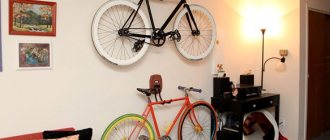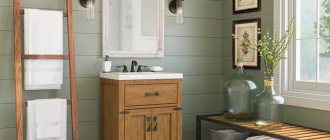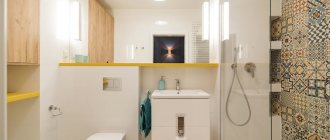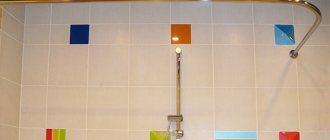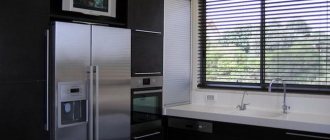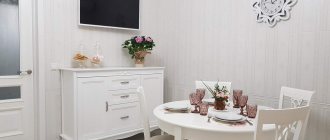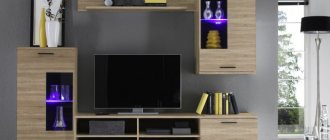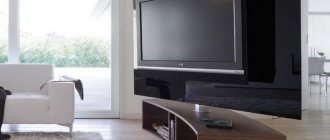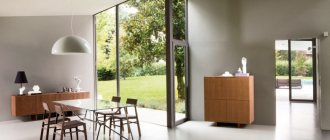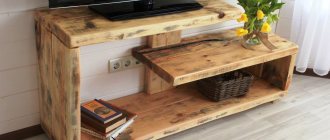One of the popular design solutions is to install built-in TVs in mirrors.
When turned off, such a mirror is no different from a regular one, and when turned on, part of it is transformed into a television screen. Photo: Mirror Media They have been trying for a long time to fit a TV into the interior, leaving only the screen visible. One of the first successful attempts involved the use of video projectors. The device itself is placed somewhere in a secluded place, for example under the ceiling. When turned off, the projector is invisible and does not interfere with anyone. We will talk about projectors in a separate article.
LG OLED65W7 flat-screen TV with picture-on-wall design. The TV is equipped with magnetic mounts, with the help of which it fits tightly to the wall. Photo: LG
As for conventional TVs, modern models can have such a thin body that if you install the TV close to the wall, from a distance of 2-3 m you may not be able to tell whether the TV is receding from the wall or its screen is it strictly in one plane. For example, LG Signature TVs are 2.57mm thick. They can be equipped with ultra-flat brackets, thanks to which the surface of the screen is moved away from the plane of the wall by about 1 cm. Similar flat kits are being developed by other manufacturers, for example Samsung and SONY. And if you still want to completely embed the TV into a wall or furniture, then you will need special models that do not require case ventilation.
Conventional TVs require space around the body to prevent the electronics from overheating. Therefore, they cannot be installed under glass or in deep niches. For such architectural installations, built-in TVs from brands such as Ad Notam and Mirror Media are used. They can be installed inside wall structures, fully or partially built into furniture in the living room, kitchen or, for example, bedroom.
Photo: Mirror Media
For bathrooms and other rooms with high humidity, there are special TVs with the required level of moisture protection (minimum IP44). These are, for example, the brands AquaView, Avel, the same Mirror Media and Ad Notam. They can be installed either in a built-in version or on a regular bracket stand. A very popular “mirror” installation is when the TV is mounted in a mirror so that it is invisible when turned off. Such installation is technically complex; in addition, it requires a connection to the electrical network in accordance with the rules of the Electrical Installation Regulations, so these procedures should be trusted to specialists.
Photo: ShutterStock/Fotodom.ru
What to consider when determining height
The main task of a TV on the wall is to view it, that is, the height should be suitable for all viewers. Therefore, first of all, evaluate - from what position do you plan to watch the programs? If this is a sofa, then you need to take into account the standard position of a person - sitting or reclining. Place the TV screen at eye level.
What are the dangers of improperly installing the TV:
- Higher than necessary. The head is constantly thrown back, the neck muscles are tense. Headaches and cramps occur.
- Lower than necessary. Head down. Pain in the cervical spine and headaches may occur.
- Closer than necessary. Sitting too close means increasing the strain on the eyes several tens of times, which will lead to deterioration of vision.
- Further than necessary. You will have to constantly strain your eyesight, it will be uncomfortable, you won’t be able to see the details.
At what distance should you hang the TV?
The most optimal distance from the viewer to the TV in terms of comfort and safety is 3-4 screen diagonals. That is, if the TV screen is 20 inches, then you need to watch it from a distance of approximately 60-80 inches (1.5-2 meters). This rule must be observed especially when it comes to a plasma TV.
LCD TVs can be viewed from a distance of 2 diagonals, but it is still advisable to maintain a distance of 3-4 diagonals.
When watching TV, it is best to sit so as not to move from the center point of the screen by more than 15-20 degrees, maximum 30 degrees.
Basic rules for placing a TV:
- position the display so that the center line is opposite your eyes;
- install a bracket with adjustable position if you want to watch broadcasts from different places;
- do not place the TV on the wall above appliances that emit heat (fireplace, radiator, hob);
- take into account the height of the household, the height of the furniture seats, when calculating the distance from the floor - the average value is 80-120 cm.
Installation procedure and necessary tools
The new equipment is in the box, all the parts of the bracket with fasteners and instructions are on the table - it’s time to do the installation. It is better to prepare the entire tool in advance so that you do not have to look for it during the assembly and installation process:
- perforator (door);
- a set of screwdrivers or a screwdriver;
- drill of suitable diameter;
- roulette;
- pencil;
- level.
Now you can start installation:
Using a tape measure and a level, make markings on the wall. You should carefully check the distance between future holes so that they do not have to be widened or re-drilled later. This may cause the bolts or dowel screws to become loose and cause the TV to fall.
- Drill holes.
- Install and secure the base of the bracket to the wall.
- Attach the guides to the TV.
- Connect the guides and the main part of the bracket together.
Important: If the bracket is a single structure, it is initially attached to the TV and only then fixed to the wall according to the finished markings.
If the TV is small, you can install it on the wall yourself, without involving help. For heavier models, it is worth using outside help.
If installation is not carried out on a brick or concrete wall, you may need additional tools and special fasteners:
- Plasterboard wall. Installation is carried out only on the internal wall profile or mortgages, which are installed during the creation of the pier. A butterfly dowel is used as fastening.
- Wooden partitions. Self-tapping screws are used to secure the stand.
- Wall made of fragile materials. For installation, through holes are drilled, fixation is carried out using bolts, and wide washers must be used.
Calculation of the correct position
It is for the sake of comfortable relaxation and watching TV shows that a TV is actually purchased, but for each room the height of its placement will be different. Why and at what height is it better to hang a TV receiver?
Watching programs in the kitchen soon turns into listening, so the height of the screen is not very critical, and in the kitchen the TV panel is hung higher than the calculated height, so that it does not interfere with work. Such fastening does not cause discomfort when watching programs.
To decide at what height to hang the TV in the living room, they start from maximum comfort when watching.
Medical studies have proven that the most optimal way is to mount the TV so that the distance from the bottom edge of the screen to the floor is 0.75-1 m.
Doctors also give practical advice on how to intuitively calculate the distance from the viewer to the TV screen. To do this, sit in the place from which you plan to watch TV, close your eyes, and after a minute open them. Where your gaze immediately fell, that place should be the middle of the screen.
At what height should you hang the TV on the wall in the bedroom? The recommended installation height of the panel will be slightly higher than in the hall or living room, and you can determine the placement point of the device in the same way as with the previous solution, i.e. just lying on the bed. The main rule when calculating the installation height of a television panel is your comfort when viewing.
In modern TV models, the picture does not flicker, and the screen does not emit electromagnetic waves, that is, it does not pose a danger to the eyes.
Therefore, you can watch a liquid crystal or plasma panel at any convenient distance, and installing a TV on the wall is possible in any case.
But the optimal ratio between the TV diagonal (the diagonal is the length between the upper and lower corners of the screen) and the distance from it to the viewers’ eyes still exists.
Photo gallery of a niche for a TV
Sources
- https://mirdizajna.ru/nisha-pod-televizor-iz-gipsokartona/
- https://www.ivd.ru/dizajn-i-dekor/mebel/oformlyaem-nishu-pod-televizor-10-idej-dizajna-i-50-fotoprimerov-40941
- https://ars.ru/nisha-pod-televizor-v-sovremennom-interere-kvartiry-78-foto/
- https://design-homes.ru/idei-dlya-doma/nisha-pod-televizor
- https://lafoy.ru/nisha-iz-gipsokartona-pod-televizor-75-foto-104
- https://GoGoSmart.ru/texnika/televizor/periferiya/nisha-pod-televizor.html
- https://Trizio.ru/nisha-pod-televizor-iz-gipsokartona-foto-idei-201
- https://vse-postroim-sami.ru/home/mebel-i-elementy-interera/8863_kak-sdelat-nishu-iz-gipsokartona-pod-televizor-poetapnaya-instrukciya-s-foto/
Placement in the bedroom
Placing a TV in the bedroom depends on many important reasons. One of the main things is what kind of bed you have. If you close your eyes while lying on your low bed and relax for a while, then you can take the most comfortable position for you when watching programs.
By opening your eyes and mentally marking the place on the wall where your gaze falls, you will receive an answer at what height is best to hang the TV in the bedroom.
Most likely, it will be slightly higher than where the TV is installed in the living room, but you should remember the advice of doctors - do not exceed the angle of deviation from the center of the screen when viewing, which Ideally it should be no more than 30 degrees.
Otherwise, osteochondrosis of the cervical spine, which occurs due to incorrect head position and prolonged viewing of television, will soon make itself known.
To more accurately adjust the deflection angle, care should be taken to use high-quality mounts for brackets with a variable inclination angle for installing the TV on the wall. monitor plane.
It is advisable to use brackets that adjust the monitor position in two planes, not only in tilt, but also in rotating the screen left and right.
Before installing a TV in the bedroom, you need to find the place from which it is most likely to be viewed. For a lying position, you should choose a higher height: slightly higher than the usual direct gaze in a standing state.
The ideal option is still considered if the tilt angle during viewing changes no more than 30 degrees from the center of the screen.
As a way out, you can use a wall bracket. In this case, you can change the rotation of the TV at any time.
The bracket is attached as follows:
- The middle of the bracket is fixed at a level of 150 cm from the floor.
- Outlets for sockets and cables are mounted 25 cm above the bracket.
At what height should a TV hang in the kitchen?
The standard use of the receiver in the kitchen is as a background for cooking or during a lunch break. One way or another, people look at the screen itself in fits and starts, so hang the TV on the wall almost any way you like.
In the dining area, the preferred location is above the table, at a level of 1.2-1.5 meters from the floor. In the work area - above the refrigerator or in any free area.
Consider unsuitable proximity:
- It is considered unacceptable to place near heating devices (cooking, oven), wet areas (sink);
- Because of the sun's glare, it is equally uncomfortable to watch a TV located on a wall with a window opening or opposite it.
When calculating at what distance from the floor to hang the TV in the kitchen, analyze your habits. If you watch it more often while cooking, calculate the level based on your standing height. Are you used to learning the latest news over a cup of coffee? Set at eye level while sitting. A tilt-and-swivel bracket would be useful for the kitchen - then you can use the TV while standing at the stove or sitting on a chair at the dining table. The panel is installed at the highest suitable point, and in order to look from below, it is simply tilted. The main thing is to position it in such a way as to prevent injury when the panel is tilted.
How to design a niche for a TV
The design of a niche for a TV needs to be approached creatively - it can be partially or completely painted with water-based paint, covered with wallpaper, sheathed with flexible stone, fabric, painted by hand or using stencils, decorated with polyurethane stucco, laid out with mosaics or decorative tiles. It is only important to adhere to a sense of style so that the portal does not conflict with the rest of the decor.
In the living room
As a rule, in the living room they do not limit themselves to just one recess for the TV screen, but arrange an entire wall - with shelves, interesting lighting, beautiful decor and paintings. This is an excellent alternative to outdated chipboard sets.
Plasterboard construction takes up less space than standard cabinets and shelving, and it looks more modern. In addition, having set the goal of zoning the space of an apartment, it can be installed instead of an internal partition, saving free space, materials and partially replacing furniture. Functional shelves, for example, for books, should be made of wood or durable glass - they will definitely withstand the load and diversify the design.
Depending on the chosen style, the niche for the TV in the living room can be designed in different ways. For example, country music will successfully complement a false fireplace and decorative stone; in modernity, smooth asymmetry will be appropriate; minimalism requires clear rectangular geometry; Provence will be decorated with delicate floral patterns, and classics will be decorated with columns, gilding and stucco.
But with all the splendor of the decoration, the central place should be occupied by the TV. This means that in and around the niche you should avoid clumsy, saturated details - they will compete with the video sequence, causing eye fatigue and irritation. For the same reason, it is better to close large shelves with doors so that the variety of things on them does not cause a feeling of clutter.
In the bedroom
In general, the rules for finishing a niche in the bedroom are almost the same as in the living room. The only caveat is that it is advisable to choose softer, pastel shades and unobtrusive light. Smooth lines, as well as rounded curves, are subconsciously perceived as safer and calmer than angular designs or sharp breaks. However, this is a matter of taste.
Since a small room is usually reserved for a bedroom, it is also better to make the niche compact. On the sides or below the TV you can arrange paired recesses for stereo speakers, and under them there are shelves for discs, magazines and various small items. The remaining space will be filled with photographs, interior candles or figurines.
In the kitchen
Here, the main place is given to functionality, so the TV is installed so that it is convenient to watch, and at the same time it takes up a minimum of space. The niche is placed so that it is located at a distance from the stove and sink, otherwise water and grease will get on it.
Determining the height in the children's room
Whether a child even needs his own TV in an apartment, whether it is harmful or useful, is a controversial issue. Children who are too active while playing ball can injure themselves or drop the LCD. If you are determined to install an LCD, first of all, correctly determine at what height on the wall to hang the TV.
- Firstly, like everything for children, height should be determined based on growth. This is especially true during the active growth phase, otherwise the panel will have to be re-hanged every year.
- Secondly, answer yourself the question: for what purpose is the TV installed. Playing a console is one thing, watching before bed is another.
Rules for placing the TV in the nursery:
- the position of the lower part should be higher than the child’s height to prevent impacts during games;
- Preferably the use of static brackets that do not allow the child to move or tilt the TV in order to avoid damage.
Children usually watch TV while playing or doing other activities, so it is difficult to determine the main position. Hang the bracket opposite one of the main sitting places (bed, sofa) - and the baby will figure out other options on his own.
In the case of determining a place for a TV, the saying “Measure seven times, cut once” is especially relevant. To avoid damaging the wall with extra holes, check your calculations and only then begin installation.
Color selection
Pink for girls, blue for boys - a long-gone stereotype. Pink rooms look tacky, are not suitable for teenagers and are even more impossible in dormitories for mixed-sex children.
Do you want for your daughter ? Choose its shades: dusty rose, pale purple, orchid color in a powdery version. This color can be kept as the main color for the bedroom of a schoolgirl, teenager, or even a young girl.
For boys (and not only) you can use blue, blue, green, yellow as accent colors, keeping the overall tone of the room neutral. Pay attention to this year's trending shades: mango, orchid, sea blue or grass green. Spaces in universal colors turn into rooms for adult children without major alterations. It is better to place the necessary age accents with the help of decor, textiles and toys. After all, any children's room is always full of colorful boxes of puzzles and construction sets, LOL dolls, ponies or rescue puppies.
According to scientists, the color scheme of a children's room not only affects the psycho-emotional state of the child, it can also support certain character traits of the baby. Choleric children feel comfortable in rooms with interior items and decor in blue, blue and green colors. Melancholic people feel comfortable in pastel-colored interiors. Sanguine people get high on the color purple. And phlegmatic people will cheer up if their eyes cling to something red or orange.
And most importantly: if your children are over 4-5 years old, let them choose colors too! It’s better not to trust their categorical “I want pink!”, “Black like in the trolls’ cave” or “I want to live in an ice palace, like Princess Elsa.” But in some small matters - whether the table is white or purple - it is worth listening. And the child will be happy - after all, this is his room.
IDOL DESIGN
Expand to full screen Back 1 / 20 Forward
Is it possible to hang a TV on the wall above the fireplace?
Manufacturers of LCD and plasma TVs do not recommend placing TV panels near any heating devices, or in places where the sun's rays fall most of the day. Therefore, you should not place a TV panel above a constantly functioning fireplace.
Although, if you really want, you can conduct a small experiment - measure the temperature of the wall above a cold fireplace, then heat it up and after a while measure the wall temperature again. If it does not increase or increases slightly, the TV can be hung.
Materials for niche design
A niche in the wall can be made of absolutely any shape and configuration. Among them there are several of the most common: under a furniture wall with shelves and decorative elements, under a window and a decorative fireplace installed under the TV. Depending on the style and design of the room, choose finishing materials and decorations.
From plasterboard
A niche made of gypsum plasterboard has a truly attractive and fashionable appearance and allows you to give the space some volume. In addition, gypsum board does not require large expenditures, is quite easy to use and is durable, which ensures safety for the TV device.
With the help of elastic plasterboard, you can implement all kinds of design solutions and construct various decorative niches that give the interior a special uniqueness.
From laminate
Eco-friendliness and natural motifs are the latest trends in room decoration.
Thanks to a laminate that imitates the natural color of wood, it is possible to achieve a more intricate and interesting design for the recess with a plasma TV.
From stone
Decorative stonework is a natural object with an inimitable texture that becomes a wonderful addition to any design.
This finish allows you to add a certain rigor and reliability to the interior.
Made of wood
A wooden niche is a universal decorative find, which, due to its beauty and environmental friendliness, gives the atmosphere unobtrusive expressiveness.
Brick
Such stylish interior decoration allows you to create interesting accents in the room and, depending on its original or painted appearance, give the atmosphere brutality or relaxed naturalness.
Wallpaper
By decorating a niche with the same wallpaper that covers the entire room, you can harmoniously combine the TV area with the entire interior and make it an integral part of the overall design.
Types of mounting brackets
Before hanging your TV on the wall, you should consider all types of fasteners recommended by the manufacturer.
In most cases, you can purchase three types of brackets for each model:
- hard;
- inclined;
- universal (turns sideways or up/down).
The latter are the most convenient and expensive. The first two types are purchased if you are absolutely sure that there will be no rearrangements of furniture in the near future, and the planned position of the TV will be comfortable.
A rigid mount implies a small gap for the ventilation holes of the device - about a few centimeters. The TV receiver will be installed permanently, without the ability to adjust the viewing angle.
Features of mounting a TV on the wall
Points from the mounting instructions:
- Installing a TV panel weighing more than 25 kg requires the effort of two people.
- Preference should be given to a specialist in the installation of plasma, LCD and LCD TVs. If you are confident in your abilities, then you can try to install it yourself.
- The weight of the TV must be such that the wall can support it. Overly heavy monitors should not be hung on the wall; it would be better to consider another option.
- Connection to cable and satellite networks is completed after installation.
- Manufacturers advise hanging the TV panel in a place with good air circulation to ensure the necessary ventilation through special openings in the housing.
- When mounting it on a sliding bracket, you need to keep in mind that the wiring connected to electricity is not stretched, otherwise a short circuit or fire may occur.
Installing a TV on the wall, among other things, saves space, since there is no need for bulky TV cabinets and stands.
In rooms in the minimalist style, mounting TVs on the wall is carried out for the same purpose - to remove excess furniture, but not for the sake of saving square centimeters, but to create that atmosphere of lightness, which is the main highlight of the minimalist style.
Thus, plasma and LCD TVs lighten the space, but they themselves are not at all light, especially if we are talking about a large diagonal TV. This means that hanging a flat-screen TV on the wall is much more difficult than the same picture or mirror.
TV size
A popular choice for a child's room are very small TVs, even smaller than 25 inches. However, the decision to purchase such equipment will not always be the right one - when we choose a device that is too small, the child will have to sit next to the TV to see all the details of the image. This is a very important aspect that significantly affects vision.
Before buying, you should go to an electronics and household appliances store; it would be a good idea to measure the available children's space in advance. The most popular TV sizes for a children's room are from 32 to 42 inches, but the dimensions of a particular model should be adapted primarily to the room.
Basic rules from manufacturers
Wall mounting of a TV weighing more than 25 kg is strongly recommended to be carried out by two people.
TV manufacturers constantly remind in their operating instructions that only a qualified technician should hang a TV (this applies to both plasma and LCD), since illiterate wall mounting of a TV can be dangerous.
But if you have the skills to work with a drill and have golden hands, you should not be afraid of self-installation, unless, of course, we are talking about a very heavy TV:
- Before hanging a flat-screen TV on the wall, you need to make sure that it can support its weight.
- Cable connections are made after the panel has already been hung on the wall.
- Do not install the TV in a confined space - air must circulate freely through the TV's ventilation openings.
- When hanging the TV on a movable bracket, you need to make sure that when you turn it, the power cord will not be stretched, otherwise sparking and fire may occur.
These are the main recommendations of TV manufacturers. They must be followed first. Well, now let's talk in more detail about wall mounting.
Illumination of a plasterboard niche
Lighting is a stylish and convenient tool for decorating plasterboard structures and niches. From the point of view of ease of installation and fire safety, mounted spotlights and LED strips have proven themselves to be the best. Duralight, neon tubes and threads are good for creative interiors.
Direct the light stream away from the room, otherwise it will be too bright. The most comfortable shades for vision are white and yellow, and colors can be added with blue, green or red neon. But it is not recommended to keep colored or flashing tapes on all the time: they strain the eyes.
Drywall arches (100 photos): design ideas


